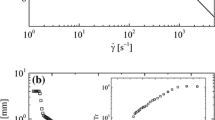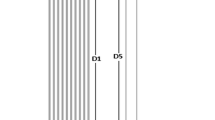Abstract
A cylinder rotating in an off-center position across a microchannel is known to generate a net flow for highly viscous Newtonian fluids. The mechanism is also known to be a viable option for the transport of viscoelastic or viscoplastic fluids albeit with a slight drop in performance. In the present work, the applicability of this mechanism is numerically investigated for the transport of (inelastic) time-dependent fluids obeying the structural-based Quemada model. By numerically solving the equations of motion, it is predicted that viscous micropumps can be used for the transport of thixotropic fluids although the obtained numerical results suggest that there exists a critical thixotropy number (a dimensionless number related to the fluid’s natural time) at which the flow rate is at its lowest value. It is shown that the critical thixotropy number can be avoided from the response of the fluid by properly choosing the geometrical parameters of the device. The general conclusion is that viscous micropumps can be deemed as an efficient mechanism for the transport of thixotropic fluids in microfluidic systems provided that the thixotropy number is sufficiently small, i.e., the fluid is strongly thixotropic. The device is predicted to be more suitable for anti-thixotropic fluids.





















Similar content being viewed by others
Data availability
The data that support the findings of this study are available within the article.
References
Yang J, Wolgemuth CW, Huber G (2013) Force and torque on a cylinder rotating in a narrow gap at low Reynolds number: scaling and lubrication analyses. Phys Fluids 25:051901
Bataineh KM, Al-Nimr MA (2009) 2D Navier–Stokes simulations of microscale viscous pump with slip flow. J Fluids Eng 131:51105–51107
Sen M, Wajerski D, Gad-el-Hak M (1996) A novel pump for MEMS applications. J Fluids Eng 118:624
DeCourtye D, Sen M, Gad-el-Hak M (1998) Analysis of viscous micropumps and microturbines. Int J Comput Fluid Dynam 10:13
Yokota K, Sato K, Itoh M (2006) Model experiment, numerical simulation and theoretical analysis on the characteristics of a viscous micropump using a cylindrical rotor in a rectangular duct. JSME Int J: Ser B - Fluids Thermal Eng 49(2):393
Day RF, Stone HA (2000) Lubrication analysis and boundary integral simulations of a viscous micropump. J Fluid Mech 416:197
Matthews MT, Stokes YM (2012) Lubrication analysis and numerical simulation of the viscous micropump with slip. Int J Heat Fluid Flow 33:22
Sharatchandra MC, Sen M, Gad-el-Hak M (1997) Navier–Stokes simulations of a novel viscous pump. J Fluids Eng 119:372
Abdelgawad M, Hassan I, Esmail N, Phutthavong P (2005) Numerical investigation of multistage viscous micropump configurations. J Fluids Eng 127:734
da Silva AK, Kobayashi MH, Coimbra CFM (2007) Optimal theoretical design of 2-D microscale viscous pumps for maximum mass flow rate and minimum power consumption. Int J Heat Fluid Flow 28:526
Lu J, Ding J (2010) Flow dynamical behaviors and characteristics of aligned and staggered viscous pumps. Int J Heat Mass Transf 53:2092
Choi HI, Lee Y, Choi DH, Maeng JS (2010) Design optimization of a viscous micropump with two rotating cylinders for maximizing efficiency. J Struct Multidiscip Optim 40:537
Khozeymeh-Nezhad H, Niazmand H (2018) LBM simulation of fluid flow in a viscous micropump with non-circular rotors and RSM approach for multiple response optimization. Int J Heat Fluid Flow 71:392
Kang DJ (2014) Effects of channel curvature on the performance of viscous micropumps. J Mech Sci Technol 28:3733
Lu J, Ding J, Yang J, Yang X (2014) Steady dynamical behaviors of novel viscous pump with groove under the rotor. Int J Heat Mass Transf 73:170
Hu C, Wu W, Hu J, Yuan S (2016) Flow dynamical behavior and performance of a micro viscous pump with unequal inlet and outlet areas. Eng Appl Comput Fluid Mech 10:443
da Silva AK, Kobayashi MH, Coimbra CFM (2007) Optimal design of non-Newtonian micro-scale viscous pumps for biomedical devices. Biotechnol Bioeng 96:37–47
Zhang B, Liu X, Sun J (2016) Topology optimization design of non-Newtonian roller type viscous micropumps. Struct Multidiscip Optim 53:409–424
Taghilou B, Sobhani SMJ, Pourjafar-Chelikdani M, Mahdavi Nejad A, Ghoroghi MR, Sadeghy K (2021) On the use of viscous micropumps for transporting viscoelastic fluids in channel flows: a numerical study. J Non-Newton Fluid Mech 291:104528
Pourjafar-Chelikdani M, Lavaf A, Taghilou B, Almasi S, Kowsar S, Najafi-Astmal H, Mahdavi Nejad A, Sadeghy K (2022) On the use of viscous micropumps for the transport of yield-stress liquids in microfluidic systems. J Non-Newton Fluid Mech 308:104894
Quemada D (1998) Rheological modelling of complex fluids I. The concept of effective volume fraction revisited. Eur Phys J - Appl Phys 1:119–127
Derksen JJ, Prashant (2009) Simulations of complex flow of thixotropic liquids. J Non-Newton Fluid Mech 160:65–75
Abdelgawad M, Hassan I, Esmail N (2004) Transient behavior of the viscous micropump. Microscale Thermophys Eng 8:361
Popel AS, Enden G (1993) An analytical solution for steady flow of a Quemada fluid in a circular tube. Rheol Acta 32(4):422–426
de Souza Mendes PR (2009) Modeling the thixotropic behavior of structured fluids. J Non-Newton Fluid Mech 164:66–75
Acknowledgements
K. Sadeghy would like to thank Iran National Science Foundation (INSF) for supporting this work under Contract No. 99001855. The authors would like to thank the respectful reviewers for their constructive comments.
Funding
Iran National Science Foundation, 99001855, Kayvan Sadeghy.
Author information
Authors and Affiliations
Corresponding author
Additional information
Publisher's Note
Springer Nature remains neutral with regard to jurisdictional claims in published maps and institutional affiliations.
Appendices
Appendix A: Anti-thixotropic fluids
Time-dependent fluids encountered in the real world are often realized to be thixotropic. Having said this it should be conceded that there are time-dependent fluid that are anti-thixotropic (or, rheopectic). In other words, their viscosity increases with time at any given shear rate. In such fluids, upon structure breakdown by shear stresses, larger microstructures are formed through bridging between the micelles thereby giving rise to an increased viscosity as time progresses. In this Appendix, we investigate the possibility of transporting such fluids by viscous micropumps. Here, we just compare the response of the two types of time-dependent fluids in a typical test case. As earlier mentioned, Quemada model can represent anti-thixotropic fluids provided αβ < 0 and \(\mu_{0} < \mu_{\infty }\). Figure 22 shows a comparison between thixotropic fluids (β = 2) with anti-thixotropic results (β = − 2) for a typical α = 1. The behavior of the two fluids is seen to be completely at odds although both types of fluids exhibit a critical Tx which appears to be around 2 (for this set of parameters). Interestingly, for any given Tx, the average velocity is larger for anti-thixotropic fluids suggesting that they are more suitable than thixotropic fluids for being transported in microfluidic channels by viscous micropumps.
Appendix B: Plane Poiseuille flow of quemada fluid
In the main body of the text, it has been shown that COMSOL is well capable of recovering the analytical velocity profiles in pipe flow for Quemada fluids [24]. We could not find similar velocity profiles for the plane Poiseuille flow of Quemada fluids. In this Appendix, we use COMSOL to obtain these velocity profiles, which are needed to ensure that at the exit plane of the viscous micropump the flow is indeed fully developed. With this in mind, Fig. 23 shows typical velocity profiles (made dimensionless using the centerline velocity) in plane Poiseuille flow for thixotropic fluids obeying the Quemada model at several viscosity ratios, with one of them representing Newtonian fluids. This figure shows that by an increase in the viscosity ratio, the flow rate is decreased. This is not surprising realizing the fact that for a given infinite-shear viscosity, an increase in the viscosity ratio means a larger zero-shear viscosity which reduces the flow rate for a given pressure gradient.
Rights and permissions
Springer Nature or its licensor (e.g. a society or other partner) holds exclusive rights to this article under a publishing agreement with the author(s) or other rightsholder(s); author self-archiving of the accepted manuscript version of this article is solely governed by the terms of such publishing agreement and applicable law.
About this article
Cite this article
Pourjafar-Chelikdani, M., Heidari, M.Y., Vakili, A. et al. On the use of viscous micropumps for the transport of thixotropic fluids. Korea-Aust. Rheol. J. 36, 55–69 (2024). https://doi.org/10.1007/s13367-023-00083-w
Received:
Revised:
Accepted:
Published:
Issue Date:
DOI: https://doi.org/10.1007/s13367-023-00083-w






